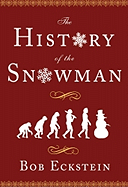
 At first, Bob Eckstein's arguments for the cultural importance of the snowman seem specious. For example, that there are no Harry Truman or Charo candlestick holders but plenty of snowmen; that snowmen have graced more magazine covers than Muhammad Ali; and that snowmen represent "the most naked, simple portrait of our humanity." But by page 7, with the inclusion of "The Snowman's Index" (who knew that 16% of Americans with the last name "Snowman" live in Florida?), Eckstein easily convinces the reader that the snowman ("a frozen Forrest Gump") is more than just cute or kitschy.
At first, Bob Eckstein's arguments for the cultural importance of the snowman seem specious. For example, that there are no Harry Truman or Charo candlestick holders but plenty of snowmen; that snowmen have graced more magazine covers than Muhammad Ali; and that snowmen represent "the most naked, simple portrait of our humanity." But by page 7, with the inclusion of "The Snowman's Index" (who knew that 16% of Americans with the last name "Snowman" live in Florida?), Eckstein easily convinces the reader that the snowman ("a frozen Forrest Gump") is more than just cute or kitschy.Journeying backwards through time, Eckstein searches for the first snowman, moving from the present "age of expansion" where snowmen are making a comeback in the consciousness (just in time for global warming), through the "white trash" years of the last quarter of the 20th century (featuring killer snowmen in film, snowman porn websites, etc.), to the snowman as political statement in the 19th century, and all the way back to the 14th century.
All levity and snow puns aside (Eckstein is a cartoonist and humorist), this brisk, charming book is well researched and full of entertaining, informative nuggets. For example:
- There are no snowmen in the dry, cold Arctic where humidity is below 20% and the temperature below 10° F--both must be higher in order to pack snow.
- The Association of Education Publishers has banned the use of the word "snowman" in textbooks because it is gender biased.
- The Taliban banned snowman-making when it came to power in 1996.
On a more serious note, when Eckstein does find that first snowman in a 14th century manuscript in the Hague, it turns out to be an anti-Semitic illustration; something Eckstein calls "truly unfortunate" as the key appeal of snowmen, at least in modern times, is that they are nondenominational. Yet he also repeatedly finds pathos in the appearance of snowmen over the centuries and shows convincingly that whether used as political statements or childhood rituals, snowmen hearken to a time when life was simpler and snow had a chance to fall before it melted. One hopes that Eckstein won't stop here, but will follow up with a sequel designed for those of us in warmer climes (possibly all of us soon). Perhaps the history of sandcastles . . . --Debra Ginsberg

